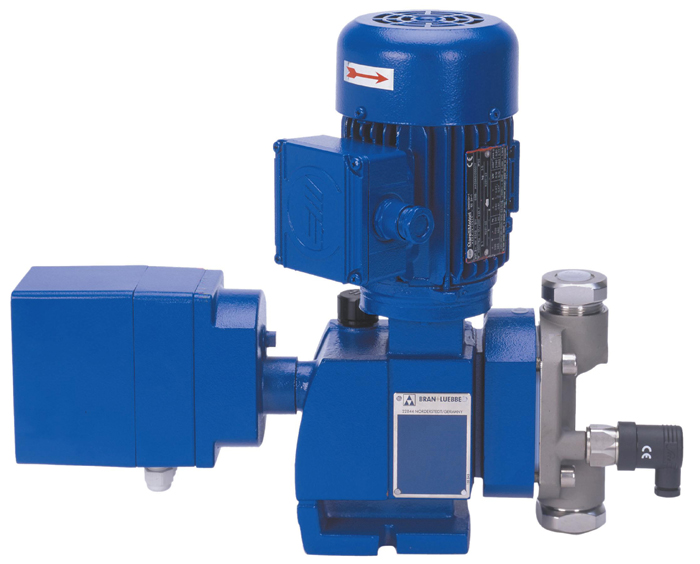
Metering pumps, dosage pumps, or dosing pumps are positive displacement pumps. They help to introduce chemicals or other substances into a steam, gas, or water stream. A dosing pump should be small for optimum control and provide very accurate flow rates. These pumps are vital in autonomous chemical dispersion systems that use integrated metering.
Not only that, but these pumps can measure flow control and dispense precise amounts of fluid. They use expansion and contraction chambers to move the fluid. Acids and bases, corrosives, viscous liquids, and slurries are just some of the many types of liquids a metering pump can handle.
What Is a Metering Pump?
Accurate dosing and delivery of chemicals or liquids are possible with a metering pump. Its principal use is the precise delivery of liquids to specified locations at specified rates of flow or dose. Typically, a metering pump comes with flow controls that you can change to control the output flow rate precisely.
Features
- Several applications
- Multiple operating principles
- Adjustable flow rate
- Precise metering
What Is a Dosing Pump?
Consider regulating the amount of chemicals supplied using an adjustable flow control device in a dosing pump. This pump type is used for adding additives or chemicals to fluid systems. It is important to keep the chemical concentration and dosage within a certain range to meet the treatment process’s needs and achieve the best possible treatment outcomes.
Dosing pumps often feature top-notch materials and state-of-the-art technology to guarantee their reliable operation. Additionally, they can adapt to various work settings and meet diverse needs. Some examples include controlling chemical reactions in water treatment, delivering disinfectants, and adjusting pH.
Features
- Resists corrosion
- Adjustable flow rate
- Various options
- Stable and reliable
- Precise dosing
- Automatic control
Here are some differences between a metering pump and a dosing pump.
Flow Rate:
Metering pumps can manage larger flow rates and help maintain a constant flow rate over a long period of time. Their ability to maintain a constant and accurate flow rate makes them ideal for applications like numerous industrial operations that require this.
Conversely, dosage pumps are commonly used for the controlled and separate administration of fluids according to the needs of individual applications. When a steady stream of additives or chemicals isn’t required but accurate dosing is, these are the best options for low to moderate flow rates.
Purpose:
Metering Pump:
A metering pump is the way to go when a procedure calls for regular and accurate dosing over a long period of time. These pumps can continually provide fluid at a set flow rate. These are the go-to machines when a constant flow rate is required, such as in chemical production or water treatment.
Dosing Pump:
The purpose of a dosing pump is to distribute a predetermined amount of fluid in batches or at predetermined intervals. They find widespread application in pharmaceutical manufacture, the production of food and beverages, wastewater treatment, and other operations requiring controlled injections of fluids at regular intervals to add additives or chemicals.
 Accuracy and control:
Accuracy and control:
Metering pumps are vital in processes where even little changes in flow rate can significantly impact the outcome. This is because they control and maintain a constant flow rate. Water treatment and chemical manufacture are two common applications where a continuous flow rate is required.
The fluid volume provided with each cycle can be precisely adjusted and controlled with dosing pumps designed for accurate dosing. Because of this quality, dosing pumps are perfect for uses requiring controlled and accurate dosing of additives or chemicals. This is because they deliver predetermined amounts of liquid with great accuracy. When precise chemical dosing is of the utmost importance, as in the wastewater, agricultural, and pharmaceutical industries, dosing pumps find widespread application.
Control and Monitoring:
Metering Pump:
Modifying the flow rate in response to real-time feedback, external control systems, and feedback loops are common features of metering pumps that provide advanced monitoring and control capabilities.
Dosing Pump:
Some dosing pumps may include simple controls that allow you to change the dosage and how often it is administered. Batch or periodic dosing is a common configuration for these.
Pumping Mechanism:
Metering Pump:
Some mechanisms metering pumps use include peristaltic pumps, piston pumps, and diaphragm pumps. Their design prioritizes continuous operation over short bursts.
Dosing Pump:
Peristaltic pumps and diaphragm pumps are common types of dosing pumps. This is because they allow for precise and sporadic dosing.
Applications:
Metering Pump:
Some common uses include continuous process maintenance of particular chemical concentrations, pH control, chemical injection, and disinfection.
Dosing Pump:
In batch processes, like those found in labs, pharmaceutical manufacturing, and the food and beverage industry, dosing pumps help to add specific amounts of additives, reagents, or chemicals.
An Ideal Option for Dosage Systems
Depending on the application, metering or dosing pumps are used with dosing systems. You can add medications and other liquids to other fluids using dosing pumps. Pharmaceuticals and water treatment are two examples of typical applications for dosing pumps. These allow for exact control of flow rates. Accurately adding one fluid to another is the job of metering pumps. Applications requiring exact control of additive concentrations, like oil and gas, are common uses for metering pumps.
How to Maintain the Pump
- Adjust flow rate
- Adjusting the controller
- Inspect seals and lines
- Keeping it dry
- Regular replacement of parts
- Maintain cleanliness frequently
In conclusion
Consider your application’s needs carefully before deciding between a dosing pump and a metering pump. It is better to use a metering pump if you require a constant and accurate flow rate. A dosing pump is the way to go when you need to dose additives and chemicals precisely and intermittently. Therefore, you can contact Express Drainage Solutions for assistance with these pumps.
